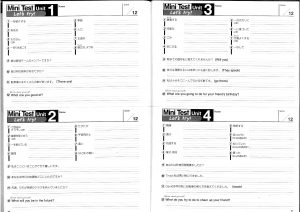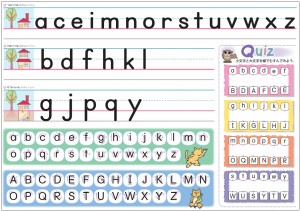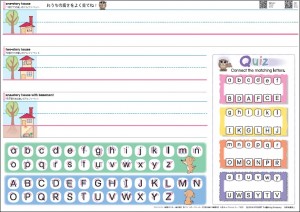

- Vol. 43 Trial lessons. What teaching materials do you recommend?
- Vol.66 New Penmanship:How do I insert underlines?
- Vol.65 How can I use a purchased "Student CD App" with a new device?
- Vol.64 Handwriting for Book 2 or Book 3?
- Vol.63 What color of Reward Stickers should I give to my student?
- Vol.62 What Picture books are suitable for lessons with BLUE textbook?
- Vol.61 What picture books are suitable for lessons with YELLOW textbook?
- Vol. 60 Is YELLOW textbook too easy for 1st grade Elementary school student?
- Vol.59 Can you print “Lined Worksheet Wizard” in black and white setting and print the words in light gray?
- Vol.58 Can I import pictures into New Flash Card Maker?
- Vol.57 Do you have other materials that includes “*** stories” and “stroke orders” which is in the notebook (8-lines)?
- Vol.56 What is the difference between 1st edition of Tomorrow and Book5 TOMORROW(2nd edition)?
Vol.62 What Picture books are suitable for lessons with BLUE textbook?
The following table shows the same categories as each unit in BLUE and picture books.
| contents in BLUE | Picture Books |
| Unit 2 Greetings / Numbers | Pal the Parrot/ Tiny Boppers |
| Unit 3 Colors / Alphabets | A Beautiful Butterfly/ abcd Chants |
| Unit 4 Animals | Open the Window / My Pet/ Me Myself(*adjectives)/ One Boy and His Friends |
| Unit 5 Family | Where is Everyone? |
| Unit 6 Food | What’s in the Cart? |
| Unit 7 Body Parts | A Teddy Bear/ With My Eyes |
| Unit 9 Seasons | Our Sweet Home |
*There are no animals in the”Me Myself” picture book but the “A Happy Cat Song” in the unit contains adjectives (happy, sad, angry, scared). “Me Myself” picture book allows students to review the various adjectives.
Vol.61 What picture books are suitable for lessons with YELLOW textbook?
The following table shows the same categories as each unit in BLUE and picture books.
| Contents in YELLOW | Picture Books |
| Unit 1 Greetings | Pal the Parrot |
| Unit 2 Numbers | Tiny Boppers |
| Unit 3 Family | Where is Everyone? |
| Unit 4 Colors | A Beautiful Butterfly |
| Unit 5 Body Parts | With My Eyes/ A Teddy Bear |
| Unit 6 Alphabets | abcd Alphabet |
| Unit 7 Animals | Open the Window / My Pet/ One Boy and His Friends |
| Unit 8 Food | What’s in the Cart? |
Picture books published by APRICOT have two series : 「Picture books series」and「Picture Books by Songs & Chants」
Students learn basic vocabulary and phrases with pretty designs in the picture books and they get use to what they learned with catchy chants and songs. All the picture books come with an Audio CD. There are workbooks available also!
Our picture books are popular for recitals!
“Picture Books On Stage” exclusively available on e-APRICOT:
Picture Books on Stage “Pal the Parrot”
Picture Books on Stage ” A Teddy Bear”
Picture Books on Stage “Our Sweet Home”
Picture Books on Stage “My Pet”
Picture Books on Stage “Who Stole the Cookies?”
Vol. 60 Is YELLOW textbook too easy for 1st grade Elementary school student?
For beginners in 1st grade elementary school students, we recommend WELCOME YELLOW. Topics like Alphabet, family, numbers, food and body parts are included in YELLOW and they can learn basic vocabulary. Songs and chants will allow students to learn basic vocabulary efficiently in a fun way. Book 1 is made for students who have learned approximately 400 words in their previous studying years (266 words in YELLOW, 315 in BLUE) and is recommended for those who have experienced the basics to start learning in earnest. There are also pages that students can try to figure what they are interested, or discuss about their own opinion in Book 1. To pick one from PINK or YELLOW or BLUE, YELLOW which includes basic words and conversation, will be the most efficient choice to start studying with Book 1.
The following steps of skipping BLUE after YELLOW are suggested depending on the students level.
YELLOW (1st grade)
Book 1 (2nd grade)
READY (3rd grade)
Book 2 (4th grade)
Book 3 (5th grade)
BRIDGE (6th grade)
TOMORROW (Junior-High)
BLUE can be an option instead of YELLOW. These two books contain similar vocabulary and sentences.
Students can learn more by using YELLOW as a basis and teachers add songs and chants from BLUE to their lessons. For example : Use songs and chants from Unit 6 – Food (BLUE) in a lesson of Unit 8 – Food (YELLOW).
Both YELLOW and BLUE contain topics such as Food, Body Parts, Family, Colors, Alphabet and Animals etc. (preposition, shapes and verbs start in BLUE as a new category)
Learning words and dialog through activities with songs and chants will help students to remember English easily, and it also helps their future studies after Book 1.
Vol.57 Do you have other materials that includes “*** stories” and “stroke orders” which is in the notebook (8-lines)?
Learning World Book 2 (1st edition,published in 1995) used to have a page on its textbook like the picture below ;
This page is useful for writing reference and we put this also on the notebook (8 lines). After receiving many requests, we released its poster version on 25th April 2018.
↓ Phonics Alphabet Posters (2 posters)
We are introducing a song themed “easy-to-remember the order strokes” (lower-cases) in association with this poster.
Download the song from here ;
https://www.apricot-plaza.co.jp/en/products/goods_sound#audio571
Check out our videos of the songs ↓
Vol.56 What is the difference between 1st edition of Tomorrow and Book5 TOMORROW(2nd edition)?
We also revised the pages on the right. Listening Test page on each unit has been changed and now there are not only Creating Writing but Presentation drafts and activities of “Think and find own answers” here and there. Other than that, we added three grammatical subjects which used to be taught in high schools such as Past subjunctive, Present Perfect Continuous and Participles.
For the workbook, there are demo tests for level 3 Eiken qualification and past exam questions from Cambridge (YLE) Movers in addition.
In the teacher’s book, it has an additional Mini Test for each unit which you can make photo copies to suit your needs.It has more contents and it is higher degree level compared to the 1st edition. The book is recommended for students who have learned Learning World Book 3 and Book 4 BRIDGE.
Mini Test <click the image to enlarge>

■TOMORROW(2nd edition) target :
From upper grades of elementary to junior-high who has been learning English since pre-school or lower grades of elementary. It is also possible to use the 2nd edition after they studied the 1st edition. Students can review what they have learned in the previous year and understand more deeply.























